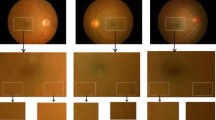Abstract
Opacity of the cornea is one of the important indices for estimating time of death. Now the work is done by forensic medical experts. An unbiased estimation method is needed. This paper proposed a method for finding the relationship between changes of cornea and postmortem intervals by processing and analyzing images. Firstly, a histogram based image segmentation method is proposed to extract corneal regions from pictures of rabbit’s eye. Secondly, texture and color features are used to describe the extracted corneal regions. Those features are carefully chosen to represent the changes of cornea in different postmortem intervals. A KNN classifier is used to reveal the association of image features and postmortem intervals. The experimental results show that cornea image features can be used to automatically estimate postmortem interval.
This work was partially supported by HTRDP (Hi-Tech Research and Development Program of China) 2007AA01Z161.
Preview
Unable to display preview. Download preview PDF.
Similar content being viewed by others
References
Chen, H., Zhu, S.H., Fang, D., et al.: An study on the relationship between changes of corneal AQP1 and postmortem interval. Forensic science and technology (2007)
Guolin, S., Jihai, S.: Study of comeal endothelium cell and its application in forensic medicine. Forensic science and technology (1), 36–37 (2001)
Changmiao, X., Haisong, Z., Songfu, Q.: The influence of temperature on the feature parameter of the endothelial cell living rate from corpse cornea [J]. Chinese Journal of Forensic Medicine 14(1), 33234 (1999)
Wang, X.W., Shen, L.S., Liu, D.H.: An Image Processing Based Method for Cornea Opacity Analysis. Journal of circuits and systems 7(2), 18–21 (2002)
Liu, F., Peng, X., Wang, T.: A Density-based Approach for Text Extraction in Images. In: Proc. of the 19th international conference on Pattern Recognition (December 2008) (to be published)
Fusheng, W., Guoqing, Q.: Boundary tracking algorithm of objects in binary image. Journal of Dalian Maritime University (2006)
Author information
Authors and Affiliations
Editor information
Editors and Affiliations
Rights and permissions
Copyright information
© 2008 Springer-Verlag Berlin Heidelberg
About this paper
Cite this paper
Liu, F., Zhu, S., Fu, Y., Fan, F., Wang, T., Lu, S. (2008). Image Analysis of the Relationship between Changes of Cornea and Postmortem Interval. In: Ho, TB., Zhou, ZH. (eds) PRICAI 2008: Trends in Artificial Intelligence. PRICAI 2008. Lecture Notes in Computer Science(), vol 5351. Springer, Berlin, Heidelberg. https://doi.org/10.1007/978-3-540-89197-0_97
Download citation
DOI: https://doi.org/10.1007/978-3-540-89197-0_97
Publisher Name: Springer, Berlin, Heidelberg
Print ISBN: 978-3-540-89196-3
Online ISBN: 978-3-540-89197-0
eBook Packages: Computer ScienceComputer Science (R0)




